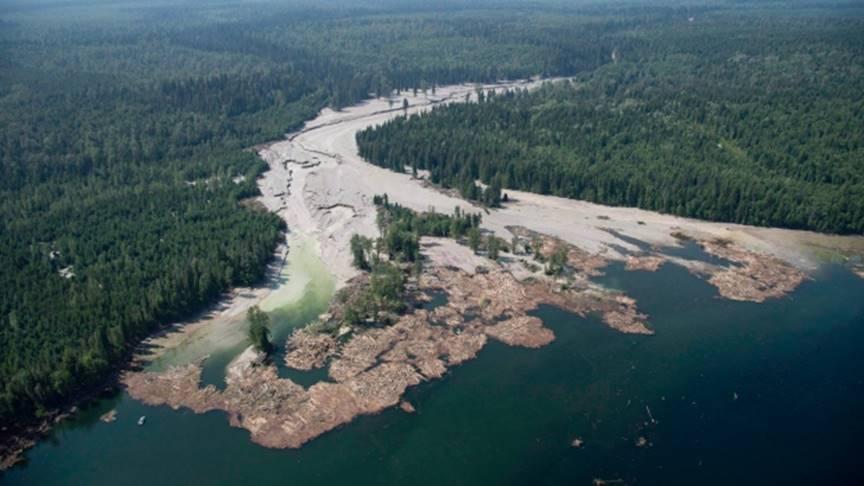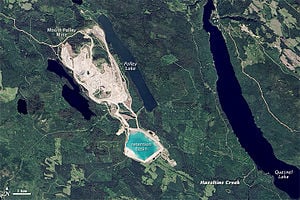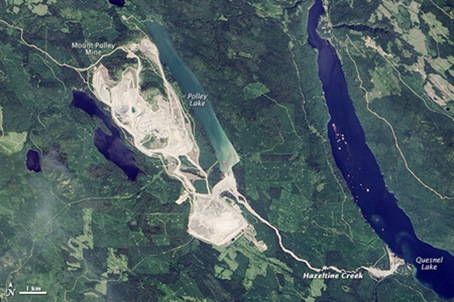|
”Environment Canada reported that the metallic contaminants that had been dumped in the Mt Polley tailings pond included these hazardous metals: Lead, Arsenic, Nickel, Zinc, Cadmium, Vanadium, Antimony, Manganese and Mercury.”
“ALL tailings “ponds” are problems. If they don’t breach and spill massive amounts of toxic sludge into the environment like at Mount Polley, they leach that contamination slowly, poisoning the waters and lands around them.” – Source
Last year, the Duluth News-Tribune published a Local News article with the title “EPA signals its support for final PolyMet review”.
The article ended with what I regard as an intentionally deceptive and woefully insufficient sentence from the DNT journalist: “Critics say the project is likely to taint downstream waters with acidic runoff.”
In a column for the Duluth Reader, which I wrote in response, I attempted to correct the notion that “acidic runoff” is the major reason for the widespread opposition to PolyMet’s proposed copper/nickel mining project (and the Twin Metals Project, which is adjacent to the pristine Boundary Waters Canoe Area Wilderness).
Both PolyMet and Twin Metals, it should be mentioned, began as Penny Stock companies from Canada and are total novices when it comes to operating copper/nickel sulfuric acid-producing mines. The companies have never earned a penny producing a product. All their revenues have come from speculators, major transnational mining corporations and other investors that are hoping that the regulatory agencies will succumb to corporate propaganda and public pressure, that the mines will be built and that they can cash in on their investments before northern Minnesota wakes up to the sobering realities.
Typical of many mainstream media outlets that depend on advertising revenues from Big Business, the Duluth News-Tribune reneged on its duty to fully inform the public on critical issues by reporting on the 2014 catastrophe at Mount Polley, British Columbia where 24 million cubic meters of toxic sludge suddenly burst from its tailings lagoon and “tainted the downstream waters” into Lake Quesnel and the Fraser River.
Note that the earthen dam that dissolved at Mount Polley was 130 feet high. The earthen dam at PolyMet tailings lagoon is projected to attain a height of 250 feet!
The Mount Polley Copper Mining Disaster of 2014
On August 4, 2014, a copper/gold open pit mine at Mount Polley, British Columbia had its huge tailings pond dam (an earthen dam) suddenly burst, massively polluting downstream streams, rivers and lakes (and probably eventually the Pacific Ocean at the mouth of the Fraser River, not to mention underground aquifers which had already been polluted during the years before the catastrophe.
The millions of tons of toxic sludge flooded into tiny Hazeltine Creek and then into the pristine Quesnel Lake, which flows into the 800 mile long Fraser River, a migratory Sockeye salmon-bearing river that empties into the Georgia Strait and the Pacific Ocean at the city of Vancouver, B.C.
Typical of most government and industry responses to such catastrophic mining industry failures, Stephen Harper’s Conservative Party government of Canada – not to mention the ruling Liberal Party government of British Columbia – tried to cover up the disaster. Hence, most North Americans on either side of the border (certainly us Minnesotans) were unaware of the event, thanks in part to our co-opted corporate-controlled media that failed to adequately report on it.
Immediately below are links to dramatic photos and videos that have been available to the US government and media agencies, but which were not reported, to my knowledge, on in the evening news of either local or regional media outlets.
Imperial Metals Corporation of Vancouver, the owner of the mine, acknowledged that they had, as is true of all metal sulfide mining operations, been continuously dumping hazardous waste into the tailings pond in the years leading up to the failure of the dam.
The following list of toxic minerals that had been dumped in the Mt Polley lagoon is taken from Environment Canada’s website here.
Environment Canada reported that the metallic contaminants that had been dumped in the tailings pond included these hazardous metals: Lead, Arsenic, Nickel, Zinc, Cadmium, Vanadium, Antimony, Manganese and Mercury.
Each of these 9 heavy metal contaminants are highly toxic to all life forms. They have no safe levels in drinking water or in the serum or tissues of human or animal tissue. These contaminants, commonly found in ALL hard rock sulfide mines, are also lethal to plant life, but only when the rock has been ground up into fine powder in the mineral extraction process.
It is important to recall that polluted aquifers cannot be de-toxified by any known process.

The photo above was taken following the Mt Polley tailings pond failure. It pictures what was once the tiny, 6 foot wide Hazeltine Creek. Photo courtesy of Clayoquot Action, Tofino, BC (www.clayoquotaction.org)
Here is a selection of links to some of the videos of the Mount Polley tailings pond dam failure:
The first one is titled: “The Unlikely Truth – The Imperial Metals Environmental Disaster”:
https://www.youtube.com/watch?v=SfanpPz8HeA
https://www.youtube.com/watch?v=xAItFxc8bME&feature=youtu.be
https://www.youtube.com/watch?v=vg3yd8GPSnA
And here is an important video of an experimental tailings dam breach that can happen to any earthen dam:
https://www.youtube.com/watch?v=bWEWVw7TGk4
“ALL tailings “ponds” are a problem. If they don’t breach and spill massive amounts of toxic sludge into the environment like at Mount Polley, they leach that contamination slowly, poisoning the waters and lands around them.”

The birds-eye view of the mouth of Hazeltine Creek (now 120-150 feet wide) as it enters into Quesnel Lake, the previously deepest, purest lake in British Columbia and a famous trout and salmon fishery that was irretrievably damaged on August 5, 2014, when 24,000,000 cubic meters of toxic sludge breached the upstream Mt Polley mine’s tailings dam and exploded downstream. The tan material in the photo represents millions of floating dead trees that were swept away in the massive flood.
Immediately below are satellite photos of the Mt Polley copper/gold mining facility’s before and after it suddenly dissolved in 2014. Note the change in color of the tailings pond, the nearby lakes and the widening of the Hazeltine Creek that directed the poisonous sludge into Quesnel Lake. The creek had been invisible to satellite photos until the flood.


All these photos depict what are considered the biggest environmental disasters in the histories of Canada and could, someday in the near or distant future, represent what could happen to Minnesota’s St. Louis River watershed, since highly toxic metal tailings/sludge/slurry/slime ponds have a substantial risk of failing, especially in the case of one of our planet’s increasingly common (seemingly annual) 100-year catastrophic floods, storms or downpours. These photos are posted here.
A Final Thought
Northern Minnesotans, Native American Water Protectors (like the heroes at Standing Rock), sportsmen, environmentalists, downstream businesses, wild rice harvesters, fish, game, birds and just plain working folks whose babies and other vulnerable beings with developing brains need non-toxic water to thrive or simply survive must understand that such relatively common catastrophes could destroy the aquifers in the BWCAW, Birch Lake, the Partridge River, the Embarrass River, the St. Louis River, the city of Duluth and ultimately, Lake Superior.
In the considered opinion of many ethical thinkers, any thinking human with a conscience would conclude that the risks are too great to allow any amateur (or experienced) sulfide mining company such as PolyMet or Twin Metals to dig either a massive open-pit mine or a below ground mine, both of which require permanent, nearby tailings ponds in which to deposit the 99.8% hazardous waste products.
The same goes for the similarly amoral, non-human corporations like Switzerland’s GlencoreXstrata or Chile’s Antofagasta. Whether the company is a minor or a major mining company, the risks of tailings pond ruptures are still too great. (Glencore and Antofagasta are the two major multinational mining corporations that control PolyMet and Twin Metals.)
The plans to open and operate permanently polluting sulfuric acid-producing copper mines in pristine watersheds that are upstream from children and other living things should be shelved for the good of the planet and the resources left in the ground where they are safe. But somehow, the legislators, businessmen and Chambers of Commerce who are often in bed with their corporate paymasters are quite willing to ignore the risks in favor of a few temporary jobs. And fattening of their bottom lines The risks seem to be OK for conscienceless corporations and their investors, but most of them don’t live downstream.
States that surround the potentially poisoned wilderness areas as well as Lake Superior and the other 4 great lakes should have a say in the issue. Bullying corporations, along with their co-opted friends in positions of power seem to be quite willing to risk permanent catastrophes such as Mt Polley.
Corporations, especially mining corporations like Antofagasta and Glencore have repeatedly earned their sociopathic labels, and so they can’t be expected to act as ethical humans, especially when billions of dollars are involved.
Addendum:
Brazil’s worst environmental disaster in its history occurred in November 2015, when the Samarco iron mine’s tailings pond suddenly emptied its toxic contents into the Rio Doce River, either killing or terminally polluting everything in its path, until it reached the Atlantic Ocean 300 miles downstream.
Nobody in Minnesota heard about either the 2014 Mount Polley disaster (British Colombia’s worst environmental disaster in its entire history) or Brazil’s 2015 Samarco disaster on our corporate-controlled TV stations, thanks to some clever press censorship and/or some conspiracy of silence to not allow Minnesota voters to be made aware of what could happen to their environment because of the hazardous tailings ponds that are at high risk of bursting and destroying the downstream environment. Citizen awareness of the risks inherent in tailings ponds would have been an early warning signal that would have impaired the progress of both Canadian Penny Stock mining company’s (PolyMet and Twin Metals) in their semi-secret plans to exploit northern Minnesota’s precious resources and then have the mess they leave behind get cleaned up by us taxpayers.
For more information and photos of the disaster, check this out.
The heavily contaminated sludge from the now-infamous Samarco mine destroyed mining and non-mining communities that happened to be downstream from the tailings pond. The massive amount of toxic sludge entered the Rio Doce river in a sudden, thunderous flood (ironically, “doce” means “sweet” in Spanish).
The poisonous sludge polluted or killed everything in its path as it flowed toward the Atlantic Ocean, a distance of 300 miles. The guilty mining company perpetrators were as helpless in dealing with the aftermath as PolyMet and Antofagasta will be when their tailings ponds break at some point in the future. (Samarco, incidentally, is co-owned and operated by the mining giants, Vale (Brazilian) and the largest mining company in the world, BHP Billiton (British-Australian).)
Before and after satellite photos of the Samarco disaster are available here.
*
Dr Kohls is a retired physician from Duluth, MN, USA. He writes a weekly column for the Duluth Reader, the area’s alternative newsweekly magazine. His columns deal with the dangers of American fascism, corporatism, militarism, racism, malnutrition, Big Pharma’s psychiatric drugging and over-vaccination regimens, and other movements that threaten the environment, prosperity, democracy, civility and the health and longevity of the populace.
All images in this article are from the author unless otherwise noted.
|